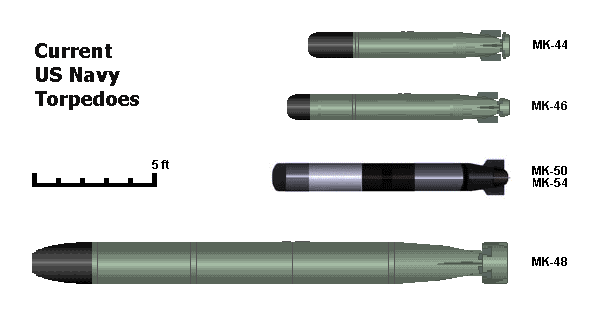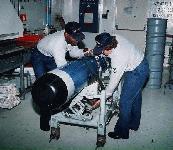





The MK-50 is an advanced lightweight torpedo for use against the faster, deeper-diving and more sophisticated submarines. The MK-50 can be launched from all ASW aircraft, and from torpedo tubes aboard surface combatant ships.
The MK 50 torpedo was developed as the next generation lightweight torpedo to gradually replace the existing MK 46 torpedo as the Navy's primary ASW weapon for aircraft (fixed wing and helicopters) and surface ships. It was intended to produce a significantly improved capability against some nuclear submarines. It has since been modified by Block Upgrade I. The MK 50 torpedo with Block Upgrade I is intended to be a contributor to precision engagement as well as full-dimensional protection. It provides the Task Force commander with an air or surface ship launched anti-submarine weapon for force protection. The MK 50 torpedo is intended to be an enabler when used to clear hostile waters of submarines, allowing amphibious forces freedom of operation. Tactically, since it is a "fire and forget" weapon, it allows the launch platform to maneuver freely following attack.
The torpedo is slightly over 111 inches long, with a diameter of 12.75 inches and weight of about 775 lbs. A sonar transducer is mounted in the torpedo nose. Torpedo operation is defined by the software associated with the Command and Control Section (CCS). The torpedo uses a closed cycle chemical reaction propulsion system. The MK 50 system includes the torpedo, ancillary support equipment, workshop test and handling equipment, and logistics support facilities. Warshot and exercise versions of the torpedo are intended to be deployed from land based patrol aircraft (P-3), ASW carrier-based aircraft (S-3), ASW helicopters (SH-2, SH-3, SH-60) and ASW surface vessel torpedo tubes.
The MK 50 program was initiated in 1974 with early operational testing [OT] conducted between 1986 and 1989. OPEVAL began in 1990 and continued into 1991. Following a hiatus to correct a problem discovered in early OPEVAL, IOT&E resumed in 1992. In OPEVAL Phase 2, discussed in detail in the 1992 DOT&E Annual Report, the MK 50 was operationally effective in some conditions, and operationally suitable. MK 50 was not effective in some areas. A torpedo software program was begun in 1992 to address deficiencies observed in OPEVAL. This was a two phased approach, Block Upgrade I (BU I) to address some concerns with small changes, and Block Upgrade II (BU II), intended to further improve performance with new algorithms. BU II will not be implemented in MK 50, but is intended for incorporation in the Lightweight Hybrid Torpedo in development. Independent operational testing of BU I found MK 50 operationally effective in some circumstances, not operationally effective against targets in some adverse environments, and operationally suitable. MK 50 with Block Upgrade I had several major deficiencies. OT-IIIA was not adequate to address all MK 50 issues. This would not normally be a major concern, since open issues were originally intended to be addressed in OT-IIIB. However, the Navy does not plan to conduct operational testing of MK 50 in key areas and scenarios. This leaves some significant operational effectiveness questions unanswered. DOT&E will continue to follow these issues, and encourage the Navy to complete operational testing. Immature tactical employment documentation and limited interoperability with different fire control systems could cause MK 50 to be ineffective. These shortfalls are being addressed by the Navy.There is no current TEMP and there has been no formal test activity in 1997. The Navy conducted some exercises involving firings of MK 50 torpedoes in realistic environments. Additionally, the Navy Undersea Warfare Center performed some evaluations of MK 50 performance.
A number of the exercise torpedo firings were considered "no-tests" because of operator errors in pre-setting and employing the torpedo; however they were in fact significant for suitability reasons. There are several inter-related causes of the errors on these "no-tests." First, there are too many dissimilar fire control systems used, some of which have confusing switch position labels, so training and tactical documentation is not universally applicable. Second, the tactical documentation is convoluted, requiring the use of several different tables (with different variants for each fire control system and weapon). The standard Navy method to overcome this artificial complexity is to train operators; unfortunately there is insufficient operational training, due primarily to the $70,000 turnaround cost for each exercise MK 50 torpedo. DOT&E identified this to the program office, and recommended that the surface ship and aircraft fire control systems be modified to interact with the operator and the torpedo in a consistent fashion, and that tactical documentation be simplified. Some modification is being implemented in some systems.
In FY97 exercise firings, the MK 50 torpedo performed well. Two revised, simplified tactical employment guidelines have been developed by the Navy. The aircraft guidelines have been approved, the surface ship guidelines are still under review. These guidelines can improve the chances of successful employment of MK 50. Firings of Block Upgrade I MK 50 torpedoes in one key area and against targets in some likely conditions remains to be done. Until such testing is done, there will be serious concerns about MK 50's ability in some scenarios. In summary, while it has some significant performance deficiencies, the MK 50 is the best air-dropped torpedo in the U.S. Navy inventory, and possibly the best in the world. Unfortunately, quantities of the expensive MK 50 are limited.


Specifications | |
| Primary Function | Air and ship-launched lightweight torpedo |
| Contractor | Alliant Techsystems Northrup Grumman [Westinghouse] Raytheon Electronic Systems |
| Power Plant | Stored Chemical Energy Propulsion System |
| Length | 112 inches |
| Weight | 750 pounds |
| Diameter | 12.75 inches |
| Speed | 40+ knots |
| Range | |
| Depth | 1,900+ ft. |
| Guidance System | AKY-14 programmable digital computer with active sonar and passive accoustical homing |
| Warhead | Approximately 100 pounds high explosive (shaped charge) |
| Inventory Objective | 1000 systems |
| Total program cost (TY$) | $3100M |
| Average unit cost (TY$) | $2.9M |
| Full-rate production | Low Rate Only |